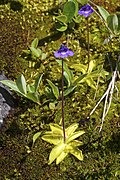Description
It grows to a height of 3–16 centimetres (1.2–6.3 in), and is topped with a purple, and occasionally white, flower that is 15 millimetres (0.59 in) or longer, and shaped like a funnel. This butterwort grows in damp environments such as bogs and swamps, in low or subalpine elevations. [1] Being native to environments with cold winters, they produce a winter-resting bud (hibernaculum). There are three forms originating from Europe: P. vulgaris f. bicolor, which has petals that are white and purple; P. vulgaris f. albida, which has all white petals; and P. vulgaris f. alpicola, which has larger flowers. [2] The taxonomic status of these forms is not universally recognised – see e.g. The Plant List. [3]
Common butterwort is an insectivorous plant. Its leaves have glands that excrete a sticky fluid that traps insects; the glands also produce enzymes that digest the insects. [4] This serves as a way for the plant to access a source of nitrogen, as they generally grow in soil that is acidic and low in nutrients, such as bogs. [4] [5] Insect capture is an adaptation to nutrient-poor conditions, and the plant is highly dependent on insects for nitrogen. [6]
This page is based on this
Wikipedia article Text is available under the
CC BY-SA 4.0 license; additional terms may apply.
Images, videos and audio are available under their respective licenses.






